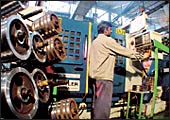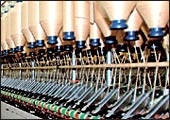| Big Is Still Beautiful |
| |
SMES |
LARGE
CORPORATES |
| Interest Rate |
PLR*+4% |
PLR
or less than PLR |
| Margins |
3-4% |
1-2% |
| Risk |
Low due to
large volumes |
Moderate |
PLR at most
lending institutions ranges from 1-.5%-13%
Source: BT estimates |
How the times
have changed. Barely five years ago, if one had asked a banker
to advance a loan to a small and medium enterprise (SME), chances
were that he would try and find some way to wriggle out of it.
Ask him now and he'll jump at the opportunity of "building
a new and mutually beneficial relationship". Yesterday's
pariah is today's sought after princess. The post-reforms Indian
economic landscape is filled with instances of ugly ducklings
turning into beautiful swans and vice versa, but seldom has banking
sentiment towards an entire segment-spanning almost the entire
industrial spectrum-shown such a dramatic and broad-based turnaround.
The reason is simple: there's lots of money
to be made from SMEs. Cherian Varghese, Chairman, Union Bank,
says the SME portfolio of the banking sector as a whole gives
1-1.5 per cent higher returns than the more pampered large corporate
segment. "The SME segment is seriously profitable; in absolute
terms, it gives margins of 2-2.5 per cent," concurs Vijay
Chandok, General Manager, Small and Medium Enterprises, ICICI
Bank.
Why are banks focussing on SMEs?
Changing market dynamics are making them
attractive to banks |
»
Government and RBI pushing for SME funding
in urban and semi-urban areas
»
Large corporates are accessing funds directly from capital
markets
»
SMEs have emerged as big producers and exporters of consumer
goods
»
SMEs have become conscious of quality, production efficiencies
and costs
»
SMEs have a repayment record comparable to the best borrowers
»
Sector gives better yields (2-2.5%) than the large corporates
»
Sector growing at over 10% per annum
»
Large corporates are increasingly outsourcing work to SMEs |
The country's largest bank, the State Bank
of India (SBI), already has an SME portfolio of Rs 80,000 crore;
and it's growing at an annual rate of 38 per cent. "Given
the size of our exposure to the SME segment, that's massive. At
this rate, we'll add another Rs 1,00,000-crore of SME assets over
the next three years," says a top official of the bank. At
the lower end of the profitability scale (2 per cent), that translates
into an incremental Rs 4,000 crore being added to the SBI bottom
line over the next three years; at the higher end, the figure
rises to Rs 5,000 crore. No wonder bankers of all hues are falling
over themselves to grab a larger slice of this pie. SMEs currently
account for about 35 per cent of SBI's asset book.
But profitability and margins are only one
side of the story. There are other operational reasons for the
banking sector's renewed love affair with the SME sector. About
three to four years ago, banks discovered that they were flush
with funds but their preferred customers, the large corporate
houses, weren't particularly keen to borrow. India Inc. found
it easier and cheaper to raise money-both equity and debt-from
the Indian and global capital markets. That was around the time
when bankers started looking at the SME sector as an alternative
destination for their funds.
It helped that small and medium companies
had cleaned up their act over the previous decade. Many individual
companies in this segment were not actually small any more; some
of them boasted turnovers of Rs 100-500 crore. And the sector
seemed set to benefit from a long-term trend-outsourcing of work
both from within and outside India. "Large corporates want
to keep their inventory levels and workforces thin and slim. So
they resort to outsourcing, whether for their back office operations
or for frontline production," says an SBI official. "This
alone can keep several SMEs in fine fettle for years."
 |
 |
"A
reasonably good quality company can get a loan in a month.
Five years back, the entire process from application to disbursement
would have taken around three months even for a Rs 200-crore
company"
Manish Kothari
Kotak Mahindra Bank |
"SME lending calls
for a certain amount of specialisation. Banks need to develop
an understanding of their clients'
needs. But once
you get the basics right, things fall
into place"
Arvind Jain
IndusInd Bank |
Today, the SME sector is the second largest
employer (after agriculture) in the country and the biggest producer
of consumer goods both for domestic consumption as well as for
exports. Most of the big exporters of cotton yarn, textiles, clothing
and gems and jewellery are SMEs. Says Chandok of ICICI Bank: "Broadly
speaking, SMEs contribute 35-40 per cent of both exports and the
country's gross domestic product. The sector is growing at more
than 10 per cent per annum; and is likely to maintain this rate
of growth in the foreseeable future."
Little wonder then, that in 2004-05, the
SME sector accounted for a 12 per cent share of the total credit
disbursed in the country; five years ago, in 1999-2000, the figure
was still in single digits. It is also much more profitable than
the much more high profile retail lending segment and not half
as risky.
But it's also not the easiest business to
handle. "SME lending calls for a certain amount of specialisation.
Banks need to develop an understanding of their clients' needs.
But once you get the basics right, things fall into place as these
relationships are of a continuing nature and the margins are so
much better," says Arvind Jain, Head, Credit, IndusInd Bank,
where loans to SMEs account for nearly 60 per cent of its total
Rs 5,500-crore corporate loan portfolio.
A vast range of financial products and services
are now also available to this sector. SMEs can now deal in treasury
products such as derivatives, which were previously available
only to large corporates, and can also avail of new technology
platforms with e-payment options, which till recently were prohibitively
expensive, and, therefore, unaffordable. "Loan approvals
have also become much easier too," says Manish Kothari, Senior
Vice President and Business Head for SMEs, Kotak Mahindra Bank.
"A reasonably good quality small or medium company can get
a loan in a month. Five years back, the entire process from application
to disbursement would have taken around three months even for
a Rs 200-crore company," he informs.
|
TOP 10 SME VERTICALS
|
 |
 |
 |
|
Auto Ancillaries & Engineering
|
ICE & ITES
|
Pharmaceuticals & Chemicals
|
 |
 |
 |
|
Infrastructure
|
FMCG, Food & Agri-Business
|
Travel & Tourism
|
 |
 |
 |
|
Gems & Jewellery
|
Retail Trade
|
Textiles & Apparel
|
| |
 |
|
| |
Commodity Trading & Others
|
|
Traditionally SMEs accounted for a very high
incidence of banks' non-performing assets. Precise figures are
not available, but bankers say it was unacceptably high even a
decade back. This, in fact, explains the reluctance of bankers
to deal with the sector earlier. Consequently, the government
had to bring small scale industries (SSIs), which account for
a fairly large majority in the SME universe, under the priority
sector lending norms to force banks to lend to them. These norms
still apply to SSIs. But the diffidence in dealing with them is
clearly a thing of the past. A happy confluence of an uptick in
the fortunes of the SME sector and the use of sophisticated credit
appraisal tools-like scoring models which take into account financial
as well as non-financial data to arrive at the creditworthiness
of potential clients from the sector-has led to a win-win situation
for both parties. "NPAs in the SME sector for most private
banks are very low, and are currently in the range of 0.5-1 per
cent only," informs Chandok.
 |
 |
"The SME
segment is seriously profitable. It contributes 35 to 40 per
cent of both exports and the country's gross domestic product.
And this sector is growing at more than 10 per cent per annum."
Vijay Chandok
ICICI Bank |
"Their cost of
capital will go up,
but businesses always factor
these things
into their plans.
So, I don't see
any scope for
any disruption
due to this"
Brijesh Mehra
ABN AMRO Bank |
"Independent rating agencies such as
NSIC (National Small Industries Corporation) and SMERA (SME Rating
Agency of India) help SMEs with higher ratings access funds on
better terms than others," says Munish Dayal, President,
Business Banking, Yes Bank. For example, an SME with a grade of
1 (the highest rating for SMEs on a scale of 1-8) can get loans
at PLR (prime lending rate) minus 2 per cent. An SME with a grade
of 4 (the lowest creditworthy level), on the other hand, will
be charged PLR plus 3 per cent. Union Bank goes a step further.
"The customer with the highest CRISIL and SMERA ratings gets
a half per cent discount on interest rates," says Varghese.
The second highest rated company gets a quarter per cent discount.
But despite the improved record and the slew
of incentives on offer, SMEs still suffer some discrimination.
They pay an interest rate that's at least 2 per cent higher than
what the large business houses pay (see Big Is Still Beautiful).
"But this will change once the practice of rating SMEs is
institutionalised. I expect AAA-rated SMEs to get loans at PLR,"
says M.A. Shah, General Manager, J&K Bank.
There are some other dark clouds on the horizon.
Interest rates are hardening once more, and this is expected to
hit SMEs, which don't have access to alternative sources of funds,
harder than their bigger counterparts. "Their cost of capital
will go up," accepts Brijesh Mehra, Head (Wholesale Clients),
ABN AMRO Bank, "but businesses always factor these things
into their plans. The managements of SMEs will obviously do the
same. So, I don't see any scope for any disruption due to this."
SMEs today represent, arguably, the most
important, albeit widely dispersed, segment of India's corporate
value chain. And so long as the economy continues to canter along
at 7-8 per cent per annum and more, bankers will follow in lock
step to share in its prosperity. The beggar maid of yesterday
has truly emerged as today's new royalty.
-additional reporting by
Anand Adhikari
|

















